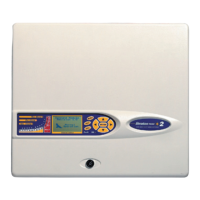Page 48
Stratos HSSD-2 • INSTALLER’S HANDBOOK • Iss. 12
11.6 Flow fault errors
• These occur when the airflow rate into the detector exceeds the pre-programmed
parameters. As the detector ‘learns‘ the flow setup from the initial installation, this
usually means that there has been some change in conditions. A Flow high fault
may indicate that a sampling pipe is damaged, and a Flow low fault may indicate
that the pipe has been blocked, e.g. by nearby building operations.
•
If the detector input is sampled from one area and the exhaust is in another area
with different pressure (e.g. the detector is in a roof space and sampling from an
enclosed room), this may lead to flow faults. In this case it would be necessary to
lead a pipe from the exhaust to the protected area to ensure nominal flow.
11.7 Cannot refit the front cover
• Check that the recessed top edge of the cover is securely located behind the
locating guard rails on the chassis (see section 5.2.1).
•
Check that the key is turned to the unlocked position (anticlockwise)
11.8 No display
• Check that the display ribbon cable is securely connected to the detector/
command module main board and to the display board as appropriate. (see
section 5.2.1)
•
Check that the display ribbon cable has not been damaged.
11.6.1 “Low flow” error messages.
• Check that the pipe giving the error is not blocked
• Check that, if the pipe is unused, the flow sensor for this pipe has been disabled
(see section 3.4.30)
•
Check that the low flow fault threshold is not set too high (see section 3.4.30)
• Consider increasing the aspirator (fan) speed (see section 3.4.28)
11.6.2 “High flow” error messages
• Check that the pipe is pushed home into the inlet and is not broken or cracked
• Check that installed pipework is fitted with an endcap.
PipeCAD
®
pipe modelling software prompts the use of appropriate endcaps. Open
bore pipes are not recommended.
•
Check that the high flow fault threshold is not set too low (see section 3.4.30)
• Consider reducing the aspirator (fan) speed (see section 3.4.28).

